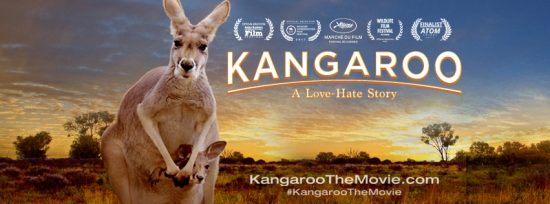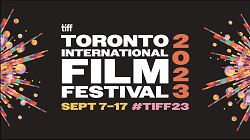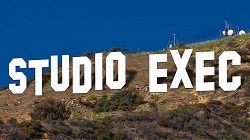Review – Kangaroo: A Love-Hate Story – “A powerful documentary”
Kangaroo has been doing the rounds on the international film festival circuit, receiving quite a bit of acclaim, and now with it being eligible for the 2019 Oscars they are making a push to get it noticed a bit wider by cinema-goers (and the Academy, the old “for your consideration”), which is how yours truly managed to get a screener to watch. And although this is very, very hard to watch in places, I am glad I had the chance to see this Australian documentary. As the film-makers and others point out early on there is a real dichotomy in the image of the kangaroo – it is the national symbol of Australia, it’s on their coat of arms, that sports-mad nation nicknames many of its teams after roos. And yet they slaughter millions of these animals every single year.
Not just slaughter, but kill often in the most disgustingly inhumane ways. Make no mistake, although this is a compelling documentary, you will need a strong stomach in certain parts of this film, it does not pull many punches in depicting just what goes on, nor should it – one of the central points here is that so many, in Australia and around the world where roo products (meat, leather) are exported, are totally unaware of what is happening, aided by a complacent government that seems to be in cahoots with a wealthy, multi-million dollar industry (and isn’t that something we’ve seen all too often in many different industries in many different countries? Strange how easily morality and decency can go when big money is involved). There are some stomach-churning scenes filmed by activists who are determined to break that cover, bring these practises out into the light – literally, as most of the hunting is done at night.
The law says any kangaroos “harvested” need to be killed swiftly and humanely, as you’d expect from similar standards in any animal food industries – we all, rightly, get sickened and outraged if cattle, pigs and sheep are made to suffer before the inevitable abattoir date and we have built up laws to protect the animals from such needless suffering. But a shooter firing at night from a truck bumping over rough terrain and firing at a moving target often miss. Many roos are hit but not fatally, some take hours, days or in one case the crew documents, two weeks to die. Two weeks of agony and suffering. And that’s not the worst – there are the baby Joeys, the mothers shot, the baby still alive but helpless. The hunters take the baby animal and swing it by its hind legs, dashing its head on the nearby Ute (that ubiquitous Aussie truck), or in one especially sickening scene, the man stands on a tiny infant Joey after pulling it from the pouch of the dead mother. Yes, I did warn you, there are some stomach-turning scenes here. I’m an old horror fiend, grew up in that first wave of unregulated “video nasties”, and can take all sorts of gore on film. If it is fictional. Seeing it inflicted on an animal for real. Not so much.
The film doesn’t use these tactics just as shockers to get your attention and raise your awareness though, it is quite clear how stressful and disturbing this is to the film-makers and to the activists who are gathering this evidence, often at the risk of their own life. One couple who film and collect evidence bought land as a preserve for wildlife, but the law allows neighbouring farmers to drive onto their land and kill roos legally. Yeah, imagine a bunch of gun nuts on a truck in the dark of an outback night driving right past your house on your ground firing away and imagine not just the animal slaughter on your own property but how easily that could end in a human tragedy too. They gather evidence in film and, gruesomely, in body parts, that are then examined by vets to prove violations of the hunting rules. The government has largely ignored such evidence before, but with green politicians getting into office now they have politicians who are able to highlight this evidence, and as well as taking it to Aussie authorities, media and people to expose the reality, they take it to other countries who import kangaroo products, which hits the industry where it hurts (suddenly big sports stars like Beckham find out their footie boot leather came from kangaroos and how they were killed, and the major companies like Adidas, unsurprisingly, soon also decide this is not good).
Maybe you aren’t an animal lover and are wondering why you should be bothered. There is more here than just respect for nature and animals though – the big industry sways government policy (you know, governments, who are meant to represent the people, not corporations) and attempts to do similar abroad (one sequence shows some rather underhand shenanigans as they try to influence Californian politicians to lift a ban in imports). And then there is the health question – the roo meat for human consumption does not get the same strict hygiene rules that beef or pork does. The shooters drive through the outback at night, shoot a roo, hang it on the back of the Ute, gut it then and there (another pretty awful scene to watch – blood, knife, innards and bolt-cutters for those strong legs. Yes, shudder), then drive on looking for more. They all have to be shot between dusk and dawn when it is cooler, but as this is allowed at night it can regularly be over 30 degrees centigrade. And it takes all night to fill the truck, so imagine all those corpses hanging in that heat for hours before being driven some distance to the nearest refrigerated storage chiller. Driven in heat on dusty, fly-ridden roads while exposed to all of that contamination and heat, spoiling away. Independent studies of roo meat on sale in shops showed high levels of salmonella and e.coli. So even if you don’t care about animal welfare and enjoy your red meat, you should be worried about this.
It’s often a hard film to watch, there are some truly disturbing scenes, but that’s part of what makes this such a powerful documentary, and the way it covers the other strands, from the big industry-government collusion, the media buying unquestioningly into the much-peddled lies (“they are vermin and need to be exterminated”, “upsetting the natural balance”), the clearly dodgy “science” government agencies use to “prove” animal numbers (which don’t stand up to even basic logical scrutiny) and the public health threat is well handled and gives a rounded picture, rather than simply dwelling on the hideously huge slaughter. The fact much of this is beautifully shot, taking in that astonishing Australian outback and the gorgeous, iconic animals themselves adds a powerful contrast to the more disturbing scenes, while the film itself lays bare not just the monstrous slaughter (millions of animals a year) and the inhumanity of it, but asks upsetting questions about just how humans, as a species, see the natural world as a resource to be used and consumed.
Check out the official site.
Check out my blog and you can follow me on Twitter.











